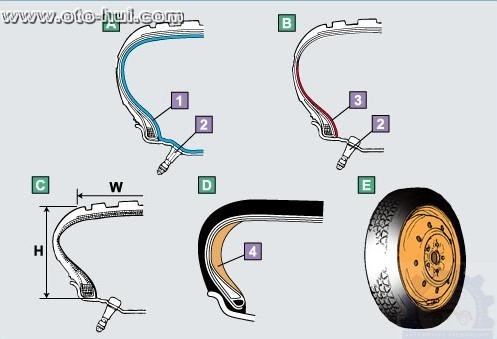Among many parts of a car, tire is the most important part that exposes to surface of the road and takes 3 basic functions namely move, turn and stop.

Composition & classification of tires
Items of periodical maintanence includes checking tire (external damages, tread depth and tire erosion), adjusting pressure and rotation of tire

1 Tread block
External layer of tire to protect carcass and avoid erosion
2 Belts (hard protection layer)
Belts are along the perimeter between tread and carcass.
3 Carcass (diagonal carcass)
Creating texture layers to create a tire
4 Inner liner
A rubber layer like sam is attached inside wall of tire
5 Bead bundle
Hold the tire on the rim.
A Round belt
Deformation on external surface is smaller than that of diagonal belt; therefore, it has better traction and rotation. Due to its high sustainable harness, it is easy to transfer vibration from the road, resulting in a decrease in smooth movement.
B Diagonal belt
Comparing to round belt, it provides smoothier movement, but rotation is affected.
Types of tire and features

A: Tire with tube
Tire with tube is inflated by gas
B: Tire without tube
There is a special rubber layer inside of the tire functioning as a tube
C: Low profile tire
Profile is the shape seen from the side of the tire, low profile tires have low cross-section with the maximum ratio is 60%
*. Thanks to low sidewall of the tire, and mild surface deformation, rotation force is significantly improved.
*: Height ratio = H / W x 100%
D: Tires can run when being deflated
Side surface of this kind of tire has intensifying rubber, so even if the car’s tire suffer puncture on the road and lose all air pressure inside, it still can run for about 100 km with a top speed up to 60 km / h.
E: Compact spare tire
The spare tire is used in case of an emergency, such as when the tires cannot work due to a hole.
It has high pressure and is narrower
1: Tubes
2: Valve
3: Internal layer
4: Intensifying lining
Parameter encoding system of car tires
Size, structure and features of the tire is indicated on the side of the tire.
The drawing on the left shows the size of the different areas of the tire.